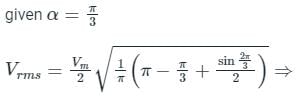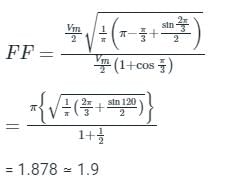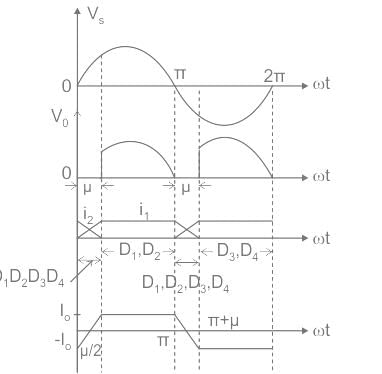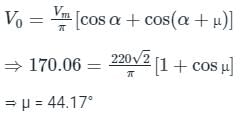Test: Effect of Source Impedence on the Performance of Converters - Electrical Engineering (EE) MCQ
10 Questions MCQ Test - Test: Effect of Source Impedence on the Performance of Converters
Consider following statements :
The overlap angle of single phase fully controlled bridge converter would increase an increasing
- Supply voltage
- Supply frequency
- Load current
- Source inductance
Of these statements
The overlap angle of single phase fully controlled bridge converter would increase an increasing
A half-wave, controlled rectifier with a purely resistive load has delay α = π/3, Calculate form factor.
What is the maximum output voltage of 3-phase full bridge rectifier supplied with a line voltage of 420 V?
A single-phase, full-bridge, fully controlled thyristor rectifier feeds a load comprising a 10 Ω resistance in series with a very large inductance. The rectifier is fed from an ideal 230 V, 50 Hz sinusoidal source through cables which have negligible internal resistance and a total inductance of 2.28 mH. If the thyristors are triggered at an angle α = 45°, the commutation overlap angle in degree (rounded off to 2 decimal places) is _______
The figure below shows an uncontrolled diode bridge rectifier supplied from a 220 V, 50 Hz, 1-phase ac source. The load draws a constant current I0 = 14 A. The conduction angle of the diode D1 in degrees (rounded off to two decimal places) is ________.

A three-phase three pulse converter, fed from three-phase 400 V, 50Hz supply, has a load R = 2 Ω, E = 200 V, and large inductance so that load current is constant at 20A. If the source has an inductance of 2 mH, then the value of overlap angle for inverter operation is
For the 3ϕ full converter having resistive load, the ripple frequency f ripple is __________.
Directions: The question consists of two statements, one labeled as ‘Statement (I)’ and the other labeled as ‘Statement (II)’. You are to examine these two statements carefully and select the answers to these items using the codes given below:
Statement (I): Inductive voltage regulation of single-phase full-wave rectifier increases with increasing supply frequency of the converter.
Statement (II): The overlap angle of a single-phase full-wave rectifier increases with the increase in the supply frequency of the converter.
A single phase full converter feeds power to RLE load with R = 8Ω, L = 8 mH and E = 46.42 V, the ac source voltage is 230 V, 50 Hz, for continuous conduction. Find the average value of load current for a firing angle delay of 45°
The frequency of ripple in the output voltage of a three phase controlled bridge rectifier depends on











































